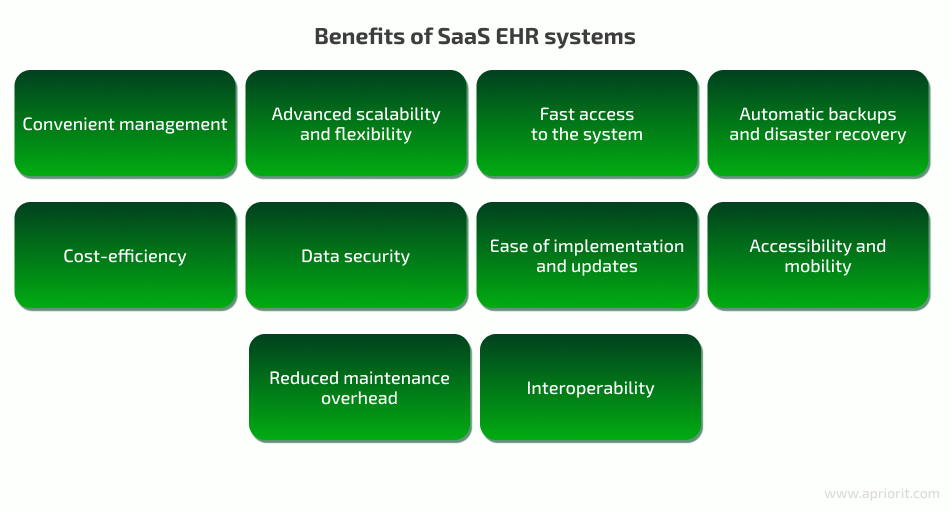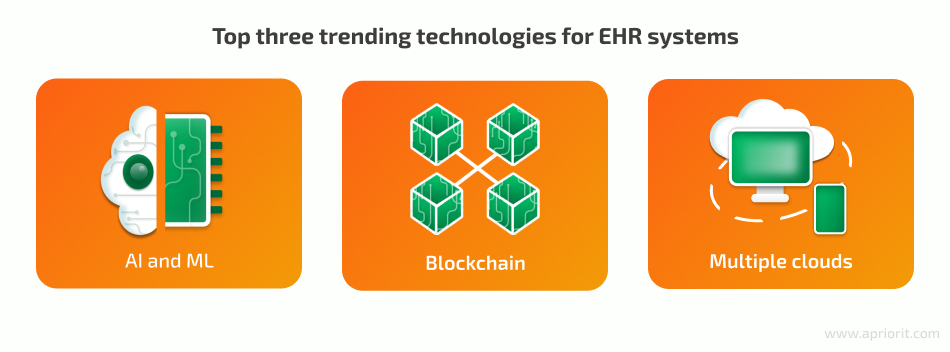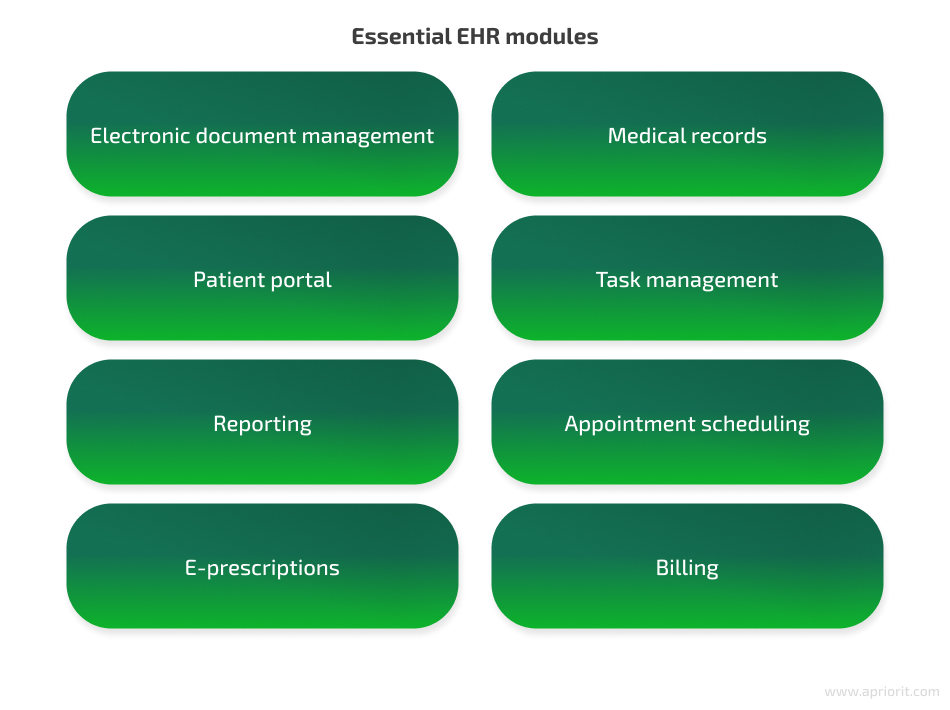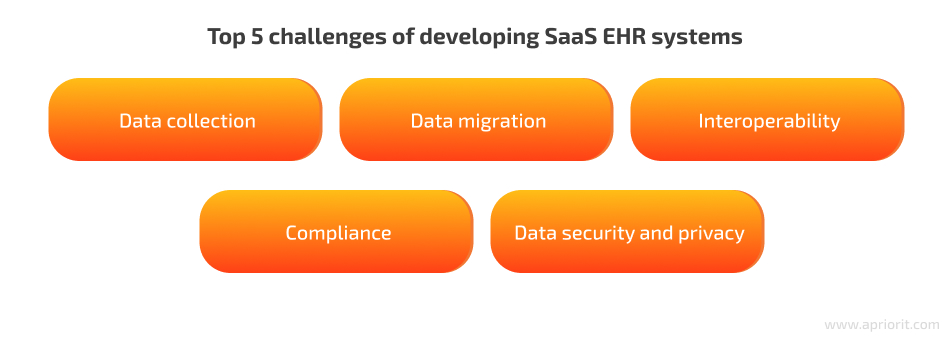A robust digital solution for data management is a must for healthcare providers. However, developing efficient tools to facilitate the workflow of medical staff, secure patients’ information, and provide high-quality services is challenging.
Healthcare solutions require a complex architecture and must meet various compliance requirements. Global and federal organizations impose strict rules for healthcare applications and systems, aiming to make security a top priority and protect sensitive patient data. Such precautions are reasonable. After all, in 2023, there have already been 600 reported cyber attacks on health systems in the US according to the US Department of Health and Human Services, including malware attacks and unauthorized access to electronic health record (EHR) systems.
One of the most promising ways of enhancing the healthcare industry with secure and efficient digital tools is using the software as a service (SaaS) model. In this article, we discuss what you need to know to build an EHR system for healthcare, what essential features to implement, and what pitfalls and challenges to expect.
This article will be useful to healthcare organization CIOs, healthcare entrepreneurs, strategy directors, and other decision-makers who are working on or planning to start developing a SaaS EHR solution.
Contents:
What are EHR systems?
Modern healthcare software solutions aim to facilitate the workflow of healthcare institutions and improve the patient experience. Such solutions are often used for arranging online consultations with doctors, storing medical databases, issuing e-prescriptions and medical bills, and so on.
Electronic health record (EHR) systems handle patients’ medical information across multiple providers. Such solutions reduce the risk of data double-entry and help doctors efficiently manage their workflows. EHR systems also enable patient portals with secure access to personal medical histories and health records and may include additional features.
The demand for high-quality EHR systems is constantly rising. According to Global Insights, the worldwide EHR market was valued at over $62.5 billion in 2022 and is expected to grow at a CAGR of 14% from 2023 to 2032. The valuation of the web- and cloud-based EHR software segment reached over $25.5 billion in 2022 and is expected to grow further.
EHR solutions are the most comprehensive tools, as they include various modules and extensive functionality, solving multiple administrative tasks at once. The software as a service (SaaS) model is one of them. Why is this model beneficial for EHR software? Let’s find out.
Need to build a secure healthcare solution?
Get a skilled development and QA team who will help you deliver a flawless and protected product to your customers.
Why use the SaaS model to build an EHR system?
EHR system development using the software as a service model is quite popular due to the vast number of business benefits. Here are the most significant advantages of SaaS EHR solutions:
- Easy implementation and management — Deploying a SaaS solution is fast, easy, and relatively effortless. Support and maintenance are usually provided by the SaaS vendor. Unlike on-premises EHR systems, SaaS systems are hosted in the cloud, which simplifies implementation within healthcare organizations. Updates and patches are managed by the SaaS provider, which reduces the IT workload for healthcare organizations and allows them to focus on patients.
- Advanced scalability and flexibility — Healthcare organizations can scale their SaaS EHR systems and adjust them for the required number of users in a few clicks. They can also configure settings for used modules and the volume of data storage.
- Fast access and mobility — With an internet connection, SaaS EHR software can be accessed from any device. This is especially beneficial for healthcare providers who need to connect with patients or access information remotely.
- Cost-efficiency — Cloud-based EHR tools offer different licensing options for various functionality sets, making software affordable for healthcare organizations of different sizes and types.
- Data security — Security is one of the key EHR software requirements. The SaaS model can offer this security if the software is implemented correctly. Encryption, access controls, and regular security audits ensure patient data is protected and minimize the risk of breaches and unauthorized access.
- Interoperability — SaaS EHR solutions use APIs to allow seamless data sharing across various operating systems, providers, applications, and platforms. This allows for a high level of integration and reduces effort duplication.
Automatic backups and disaster recovery — Cloud-based solutions like SaaS EHR systems often come with automated backup and disaster recovery mechanisms. They ensure that patient data and other data is regularly backed up and that the company can continue operating in the event of unforeseen circumstances like hardware failure.

SaaS EHR development requires thorough planning, integration with third-party systems, smooth data migration, and robust data security. The first and most essential thing to consider when building a custom SaaS solution is its architecture. Let’s take a closer look at the system modules you should pay attention to when creating an EHR system.
Read also
Developing a Secure MDM Solution for Healthcare
Provide healthcare professionals with secure and efficient communications. Discover how to build a reliable mobile device management solution for the healthcare industry.
Technology trends to use in EHR solutions
Empowering your SaaS solution with core modules and features of conventional EHR systems is the starting point. But as time goes by, new technologies arise, promising to speed up processes and increase software productivity.
Let’s discuss three major trends that can enhance your EHR SaaS solution.

1. Artificial intelligence (AI) and machine learning (ML). Both AI and ML may help you solve multiple issues in EHR solutions thanks to their ability to process enormous amounts of data fast and efficiently.
AI can be utilized within EHR systems to streamline data extraction. Healthcare providers can leverage AI algorithms to recognize key terms among different sources and quickly extract patient data from scanned documents, doctors’ notes, lab results, and other content.
EHR systems can also be enhanced with ML tools used for speech and image recognition. In particular, such tools will come in handy for turning audio records and handwritten documents into readable text. When properly trained, ML algorithms can understand a clinician’s vocabulary and precisely record notes and prescriptions. Thus, medical staff can save hours on filling out forms and documents and pay more attention to patients.
At Apriorit, we have experience developing AI-based healthcare solutions. In our case study on applying AI to healthcare, you can discover how we helped a US-based healthcare center provide more reliable and faster diagnoses with the help of AI.
2. Blockchain. Blockchain solutions are already widely used in various healthcare startups to secure data and transactions and ensure privacy for protected health information (PHI). As a decentralized system that uses timestamps to authenticate every change made to data, a blockchain ensures data authenticity and eliminates risks of data deception.
Also, blockchains are highly appreciated for their transparency. While data ownership on a blockchain is shared among trusted parties, records are secured from illegitimate third-party intervention. Transparency can help in tracking prescriptions and securing healthcare organizations from fake orders and other fraudulent activities.
A blockchain can also be used to enhance an AI-based mechanism for recognizing speech and handwritten text. Blockchains promise to provide transparency and trust, making them safe places to store generated prescriptions and other patient data.
3. Multiple clouds. Using multiple cloud services as well as SaaS providers is another trend. You may use both private clouds and hybrid clouds.
Multicloud setups can be used for various purposes, but the most essential is for disaster recovery. Even if the entire infrastructure of one cloud fails, a multicloud system will continue operating. This benefit is especially valuable for the healthcare industry and EHR solutions, where data security and integrity are the top priorities.
Related project
Building an AI-based Healthcare Solution
Learn how Apriorit accelerated and simplified doctors’ routine tasks by building an AI-based system that could track, detect, and measure ovarian follicles in video footage with astonishing accuracy.
Key components of a SaaS EHR solution
Ensuring robust functionality and data security are key to building a successful EHR solution. Perfect software for the healthcare industry is easy to use, provides medical staff with extensive functionality, and secures valuable patient information from compromise and data leaks.
Before exploring how to build an EHR system, you should concentrate on its architecture, explore the latest and most valuable technologies to implement, and foresee the likeliest challenges you’ll have to deal with. Let’s start with the EHR SaaS solution architecture and its modules.
EHR system modules
The functionality of SaaS EHR software can vary significantly depending on an organization’s goals. Core EHR features usually include management of in-hospital medication lists, prescriptions, patient histories, clinical documentation, patient care plans, etc.
Let’s take a look at some of the most useful modules you can add to an EHR solution.

Electronic document management module. This is a core functionality of any EHR tool and is supposed to help doctors access all patient-related information fast and efficiently. This includes information on health and treatment histories, lab results, X-rays, and prescriptions. Therefore, a document management module must support various data formats and ensure strong data security.
Medical record module. Healthcare providers are obliged to keep detailed documentation and charts. Therefore, you should thoughtfully design the medical records module of your SaaS EHR system. Consider equipping your solution with customizable chart templates, checkboxes, and machine learning (ML) algorithms to facilitate the routine of healthcare staff.
Patient portal. Modern EHR systems often equip patients with a special system extension that allows them to access personal health data and explore lab results and appointment histories. To improve the user experience, you can add the following features to your patient-oriented module: questionnaires before visiting a doctor, appointment scheduling, notifications on upcoming appointments and readiness of lab results, and online chats with doctors.
Appointment scheduling module. This module helps staff effectively manage appointments. It can be more convenient for some patients to schedule their visits online instead of making a phone call. Make sure to synchronize data between the scheduling module and the patient module. Notifications about upcoming appointments and changes will enhance your solution’s user experience.
Task management module. Doctors and other employees of healthcare organizations are loaded with work: advising patients, preparing reports, handling administrative tasks, and engaging in continuing education. With an advanced task management module, they can optimize their schedules, improve productivity, and prevent burnout.
Reporting module. To facilitate work for hospital administrators, your EHR software must have a robust analytics and reporting module. Such a module should provide opportunities to create reports required for financial management, disease management, health data collection, staff productivity, and so on.
Billing module. Electronic billing is a must for every EHR SaaS solution. It can save significant time for a healthcare organization’s staff when it comes to creating and checking bills, processing claims, and running financial reports. An advanced billing module should allow you to analyze revenue and provide insights into gaps in your cash flow.
Laboratory interface. Lab interfaces allow providers and doctors to order lab tests from the EHR and get results in the same system. Integration with lab interfaces allows for viewing results through reports or visualized graphs or tables. You can also add functionality for reviewing and sharing lab results with patients.
E-prescriptions. Remote prescriptions have already become standard, and EHR systems can allow physicians to prescribe medications or refill prescriptions easily. E-prescriptions save significant time and reduce paperwork. Some systems send prescriptions directly to pharmacies and notify patients when they can collect their medication.
Apart from putting your efforts into designing a flawless EHR architecture, you should also pay attention to the solution’s usability. It’s essential to develop software that works fast and has an intuitive interface.
Involve experienced QA engineers in running various tests and thoroughly checking the solution. Once your software is ready, you can gather customers’ feedback on the EHR’s efficiency and functionality to track your custom solution’s performance.
Read also
Blockchain Opportunities in Healthcare and Pharma
Power your healthcare solution with cutting-edge technology. Learn how you can apply blockchain to build a fault-proof medical record management system that guarantees patient privacy and regulatory compliance.
Challenges of developing EHR systems
Knowing how to develop EHR systems, what modules are necessary, what the latest technologies are, and specifics of the software architecture is essential. However, it’s not enough to build an efficient SaaS EHR solution. You may run into lots of challenges due to the complexity of the healthcare industry and the need to handle confidential data related to patients, medical staff, workflows, and other things.

Collecting data. Healthcare organizations work with tons of information. Therefore, your solution should be able to process various data formats.
Make sure to think ahead about ways data can be entered into your solution: manually by a nurse or a doctor as well as automatically from a patient’s smartwatch or other wearable device. Consider implementing functionality that allows for extracting valuable data from scanned or photographed documents. You may also want to apply technologies like voice recognition and handwriting recognition to simplify work for healthcare staff and stand out among your competitors.
Simplifying data migration. Enabling secure and flawless data migration between EHR systems is a challenge that’s hard to overcome without a dedicated team of data management specialists.
There are two common scenarios for migrating healthcare data: from an existing EHR system to new clean software or to a solution that’s already in use. Both are challenging, but the second option brings risks such as data duplication and data loss. Medical staff can potentially add the same person to the database twice or make mistakes when filling out patient profiles.
To simplify the data migration process for healthcare organizations, you should learn common data migration strategies and offer convenient tools. Also, provide a training mode so users can get to know how the data migration mechanism works before they start the final migration.
Ensuring advanced interoperability. A comprehensive EHR solution must be able to integrate with different third-party solutions that are used by a variety of healthcare providers, laboratories, and insurance companies.
To overcome the lack of interoperability and improve your product’s integration capabilities, pay attention to government programs for healthcare industry modernization. For instance, explore the Connecting Health and Care for the Nation. A Shared Nationwide Interoperability Roadmap developed by the US Office of the National Coordinator for Health Information Technology.
Also, you should apply standards for exchanging healthcare information electronically, like the Fast Healthcare Interoperability Resources (FHIR) specification, which applies in the US.
Complying with regulations. The healthcare industry is subject to various national and global regulations. Therefore, compliance is vital for every EHR solution. You have to ensure that all functionalities meet applicable EHR software compliance requirements.
Depending on the area where healthcare providers operate, they have to comply with corresponding local requirements. The most important are:
- the Health Insurance Portability and Accountability Act of 1996 (HIPAA), a law that places requirements on US-based healthcare organizations with regards to the management and security of electronic healthcare transactions. Pay attention to section §164.312 Technical safeguards [PDF] and make sure your solution complies with the rules.
- the Data Protection Act, which affects organizations that operate in the UK. It defines principles for data protection and empowers people to take control of their data by providing information about their rights. UK-based healthcare organizations must comply with this law.
- the General Data Protection Regulation (GDPR), a data and privacy protection regulation for businesses that operate in the European Union (EU) and the European Economic Area (EEA). If an organization is located outside these areas but serves customers from the EU or EEA, it also has to comply with GDPR requirements. Regarding EHR solutions, the GDPR provides recommendations on a European Electronic Health Record exchange format.
- Health Level Seven (HL7) Standards. HL7 is an international standards organization that develops recommendations for electronic health data exchange, integration, sharing, and retrieval. HL7 standards are focused on interoperability across various healthcare systems.
- The Health Information Technology for Economic and Clinical Health Act, or HITECH, strengthens the compliance measures associated with HIPAA. It requires healthcare providers to run regular security audits to confirm compliance with HIPAA requirements. It enforces secure health data sharing disclosure of any unauthorized access incidents to users.
You may also explore documents prepared within the NIST health IT usability initiative, such as the Technical Evaluation, Testing, and Validation of the Usability of Electronic Health Records publication, where NIST offers requirements for validation testing of EHR systems.
Read also
Applying Deep Learning to Classify Skin Cancer Types
Improve the speed and accuracy of medical diagnosis with deep learning. Discover how you can develop and implement such an algorithm with our practical examples and code samples.
Ensuring data security and privacy
Cyberattacks are costly to hospitals and health systems. The average healthcare breach now costs nearly $10 million according to IBM Security. Cybersecurity attacks pose a serious risk to patients and their privacy: in 2021, over 40 million patient records have been compromised in the US.
The laws mentioned above require healthcare providers to protect patients’ private information. Therefore, you might want to enable your EHR software with:
- Multi-factor authentication
- Advanced password security
- Data encryption with Transport Layer Security (TLS)
- Critical data backups
Also, when building a SaaS EHR solution from scratch, it’s a good practice to implement the secure software development lifecycle (S-SDLC) approach. This requires performing security-related activities during each stage of EHR software development, raising the overall level of data protection within the system.
At Apriorit, we consider all requirements when developing healthcare products and testing their security. For example, we have experience testing a mobile app for medical personnel visiting patients at home. During our testing, we uncovered several vulnerabilities and risks and provided recommendations on improving the app’s security. You can read more details about security testing for iOS healthcare applications in our case study.
Conclusion
EHR systems are crucial for an efficient workflow in healthcare organizations. In this article, you’ve learned how to develop an EHR system using the SaaS model, and how it will allow you to ensure simple management, advanced accessibility, and cost efficiency. Building a viable EHR system requires extensive software development experience, thorough research and planning, and a deep understanding of healthcare industry specifics.
At Apriorit, we have dedicated healthcare software development specialists who can provide you with high-quality custom EHR software development services and build a robust and convenient EHR solution with high security standards. Our development team can build reliable SaaS solutions not only for any needs of your business.
Need a team of SaaS developers?
Reach out to us to build a secure, reliable, and user-friendly SaaS solution for your customers!



